Have you ever imagined living in a city that anticipates your needs and responds in real-time? A city where traffic flows smoothly, energy is used efficiently, and public services are delivered exactly when and where they're needed?
Imagine living in a smart city where IoT solutions anticipate your needs and respond in real-time. From managing traffic flow to reducing energy consumption, IoT in smart cities is reshaping urban living, optimizing public services, and enhancing the quality of life for citizens. As urbanization accelerates, traditional infrastructure struggles to keep up, but IoT and smart cities are leading the transformation through innovation.
Enter the concept of smart cities powered by the Internet of Things (IoT). As more and more cities embrace Smart City IoT solutions, they're transforming the way urban spaces operate, to improve the quality of life for their citizens.
What is a Smart City? The Role of IoT in Smart Cities
IoT and smart cities are revolutionizing urban environments by integrating technologies like artificial intelligence (AI), big data analytics, and connected devices. These IoT smart city solutions enable cities to streamline resource management, enhance traffic systems, and improve energy efficiency. IoT in smart cities allows for proactive management of urban resources, helping to reduce energy consumption and optimize infrastructure.
Simply put, IoT gathers and transmits data from various endpoints like sensors, smart devices, and city infrastructure to central control systems. This connectivity empowers smart cities to make proactive and informed decisions.
Understanding IoT Smart City Architecture and How IoT Transforms Urban Life
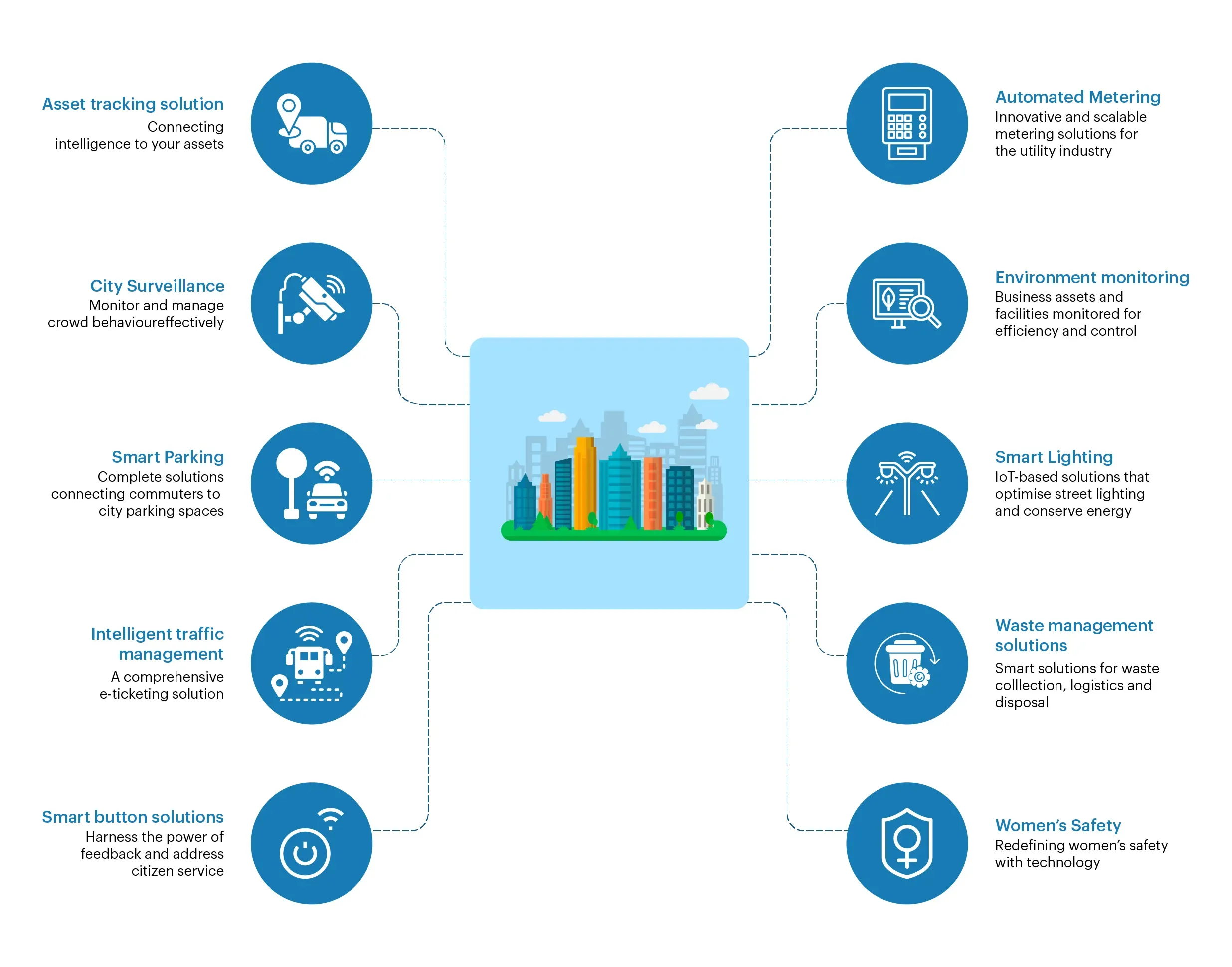
To understand how IoT in smart cities operates, let's explore the architecture that powers these innovations. The architecture of IoT smart city systems involves multiple layers working together to improve urban life. The Perception Layer collects real-time data from urban environments via sensors and IoT devices. This data flows through the Communication Layer, leveraging technologies like LTE, 5G, and cloud computing, ensuring seamless transfer and real-time processing. Finally, the Data Management Layer processes this data and generates actionable insights, which are then applied through smart city applications like smart traffic management, environmental monitoring, and smart energy grids.
1. Application Layer: Key IoT Solutions for Smart Cities
The Application Layer is the topmost layer in IoT smart city solutions, where key applications are implemented to improve urban living and address challenges such as resource management, traffic optimization, and enhancing public services. Key applications in this layer include:
Smart Healthcare
Remote health monitoring, smart hospitals, and telemedicine solutions powered by IoT improve healthcare accessibility in smart cities.
Smart Government
Smart government applications like e-governance services and real-time decision-making tools, enabled by IoT, foster transparency and accessibility in smart cities.
Smart Parking
IoT-based smart parking systems with automated management, dynamic allocation, and real-time availability checks reduce congestion and optimize parking in smart cities.
Smart Homes
IoT-enabled smart homes with automation systems for lighting, security, energy management, and climate control improve convenience and efficiency in smart cities.
Smart Grids
IoT-powered smart grids for efficient energy distribution and consumption management enhance sustainability and reduce energy waste in smart cities.
Mobile Smart Health
IoT-enabled wearable devices and mobile apps provide continuous health monitoring, optimizing healthcare interventions in smart cities.
Others
Other IoT-based smart city applications include smart education, tourism, disaster management, and more, all of which enhance urban efficiency and safety in smart cities.
2. Data Management Layer: Optimizing Data for Smart Cities
The Data Management Layer processes the data collected by sensors and devices. This layer is pivotal for turning raw data into actionable insights. Key functions include:
Event Management
Real-time data fusion, analysis, and event processing allow cities to manage multiple operations efficiently.
Decision Management
Processing and storing data to enable informed, data-driven decisions for urban management.
3. Communication Layer: Enabling IoT Connectivity in Smart Cities
The Communication Layer ensures continuous data transfer between devices, systems, and storage. This layer includes:
Support Layer
This layer provides critical computing resources, such as cloud, edge, and fog computing, enabling both centralized data storage and localized processing for low-latency operations.
Network Layer
The network layer ensures reliable connectivity, utilizing technologies like 5G, LTE, and Wi-Fi, facilitating seamless communication across the city.
4. Perception Layer: The Foundation of IoT Smart City Data Monitoring
The Perception Layer is responsible for the initial data collection and actuation. Key components of this layer include:
End Devices
IoT-enabled devices in homes, public spaces, and vehicles interact directly with the environment to gather data.
Sensors and Actuators
Sensors collect environmental data like temperature, air quality, and traffic flow, while actuators perform actions such as adjusting street lighting or controlling HVAC systems in buildings.
Core Infrastructure of IoT-Enabled Smart City Solutions
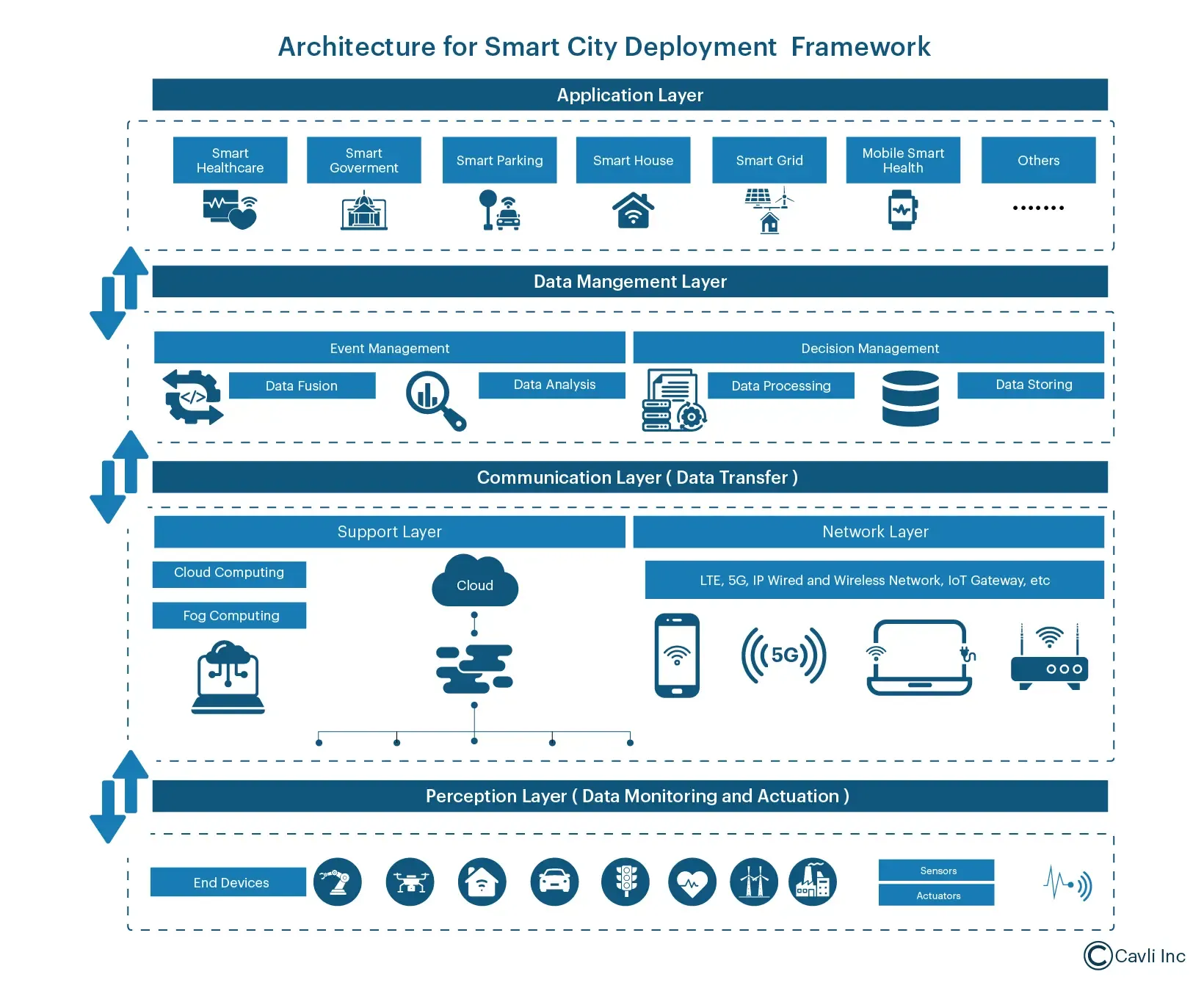
1. Smart IoT Infrastructure: The Backbone of Smart Cities
IoT in smart cities serves as the backbone of urban infrastructure, transforming transportation systems, energy distribution, and even public services. Through IoT smart city solutions, cities can achieve real-time traffic management, energy optimization, and resource efficiency.
Imagine a typical commute: Smart traffic lights adjust their timing based on real-time traffic conditions, while digital signage provides instant road updates. Similarly, smart parking systems guide drivers to available parking spaces, reducing fuel consumption and emissions by eliminating the need for drivers to circle around looking for parking.
Key elements of smart IoT infrastructure include:
- Adaptive traffic signal control systems
- Real-time public transport tracking
- Automated parking guidance
- Electric vehicle charging networks
2. IoT Solutions for Public Services and Safety in Smart Cities
Public safety in smart cities extends far beyond traditional surveillance. IoT smart city solutions integrate a variety of data sources, enabling predictive safety measures and proactive responses to emergencies. For example, when an incident occurs, smart city systems can automatically detect it, alert relevant authorities, and adjust traffic signals to facilitate emergency response.
Consider the following process during a traffic accident:
- Detect the incident using IoT cameras and sensors
- Send immediate alerts to emergency services with location data
- Adjust traffic signals to optimize route access for emergency vehicles
- Notify nearby hospitals for better preparedness
- Update digital signage to divert traffic away from the area
This integrated approach ensures improved response times, better outcomes, and enhanced situational awareness during critical events.
3. Smart Buildings and Homes
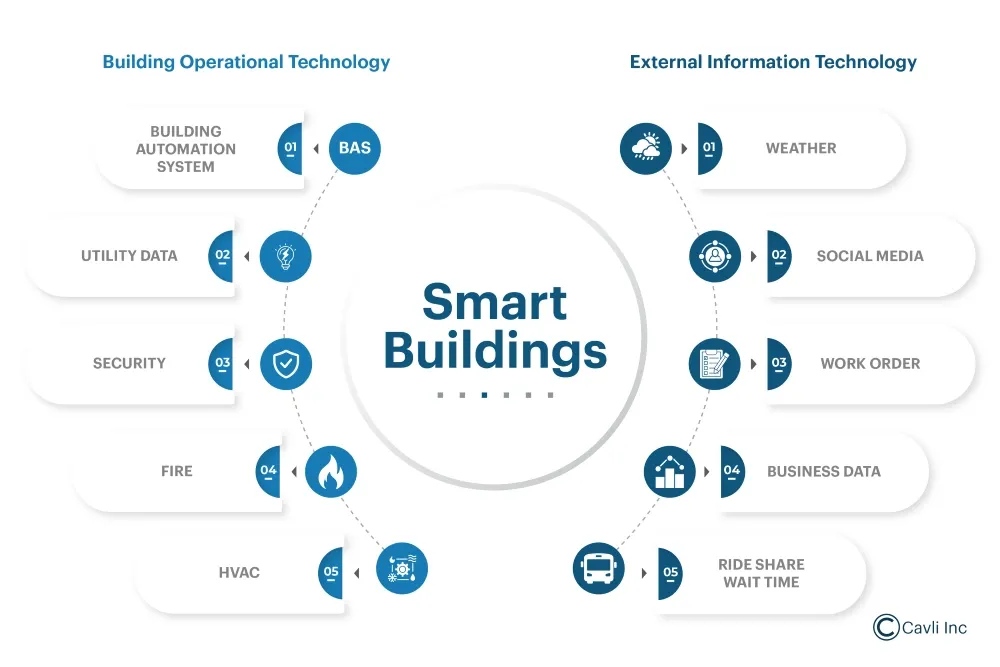
Smart buildings are pivotal in transforming urban environments into efficient, comfortable, and sustainable spaces. These buildings leverage advanced IoT technologies and automation to manage heating, ventilation, air conditioning (HVAC), lighting, security, and energy use. By using IoT sensors to monitor occupancy and environmental conditions, smart buildings can optimize energy consumption and improve user comfort.
- Monitor and adjust temperature, humidity, and ventilation based on occupancy and environmental conditions
- Optimize energy usage through smart lighting and HVAC control
- Manage access control and security systems
- Track and reduce energy consumption in real-time
A typical smart building might automatically adjust its lighting and temperature based on real-time occupancy data, potentially reducing energy consumption by up to 30%. During peak hours, the system can dim lights in well-lit areas and adjust HVAC settings, optimizing comfort while minimizing energy use.
4. Environmental Monitoring with IoT in Smart Cities
Environmental monitoring is crucial for maintaining a sustainable urban environment. With IoT-based sensors deployed throughout the city, smart cities can continuously monitor air quality, noise levels, and other environmental parameters. This enables quick responses to environmental concerns and long-term improvements in urban sustainability.
For instance, smart cities use sophisticated IoT sensors to monitor pollutants such as:
- Particulate matter (PM2.5 and PM10)
- Nitrogen dioxide (NO2)
- Carbon monoxide (CO)
- Ground-level ozone (O3)
This real-time data helps city authorities:
- Take immediate action when pollution levels exceed safety thresholds, such as imposing temporary traffic restrictions or altering industrial operations
- Alert residents with health conditions to take necessary precautions
Long-term data analysis allows cities to make informed decisions about urban planning, adjust traffic flows, and create green spaces. For instance, Beijing has implemented air quality monitoring networks that alert residents in real-time, helping them make decisions about outdoor activities.
5. Smart Parking Systems Powered by IoT in Smart Cities
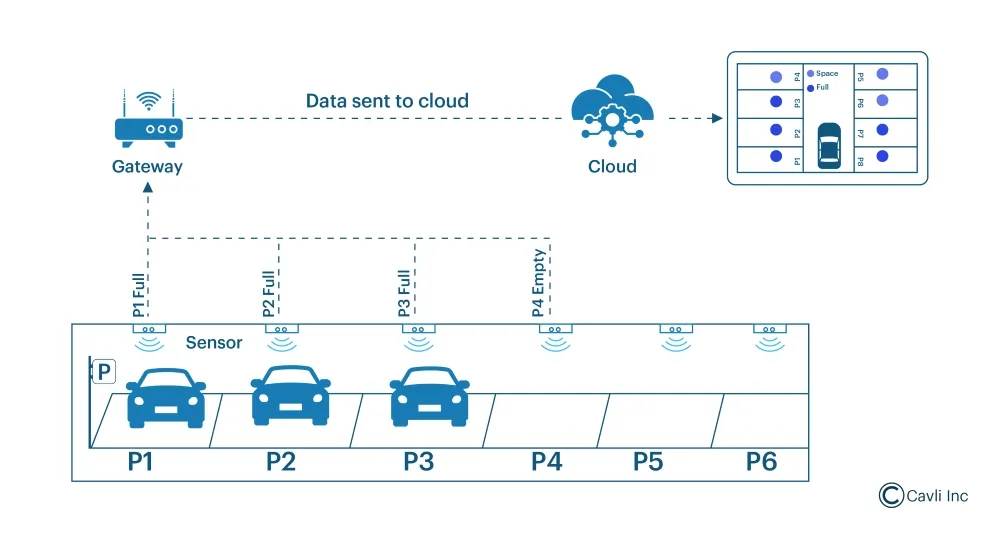
Smart parking systems address one of the most persistent urban challenges: finding parking spaces. By integrating IoT technologies such as sensors, cameras, and mobile apps, these systems optimize parking space usage and reduce congestion.
- Real-time parking space availability monitoring
- Dynamic pricing based on demand and occupancy
- Mobile payment integration
- Guidance systems directing drivers to available parking spaces
Smart parking systems can reduce the time spent searching for a parking spot by up to 43%. For instance, San Francisco’s SFpark system has decreased parking search times and reduced carbon emissions by about 30%.
6. IoT-Powered Smart Utility Metering in Smart Cities
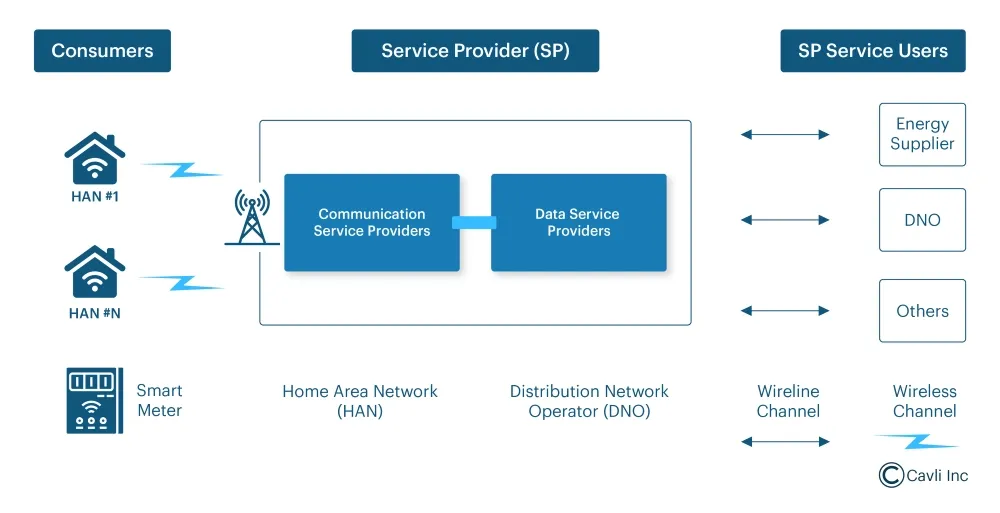
Smart utility metering is revolutionizing how urban utilities are managed. IoT smart meters offer near-real-time data on electricity, water, and gas consumption, allowing for efficient management and better resource utilization.
- Automated meter reading and billing
- Real-time consumption monitoring
- Leak detection and prevention
- Demand response management
For example, smart water meters can detect leaks early by analyzing consumption patterns, potentially saving millions of gallons of water annually. Similarly, smart electricity meters enable dynamic pricing models that encourage off-peak usage, reducing strain on the power grid.
7. IoT-Based Smart Street Lights in Smart Cities
Smart street lights are one of the most impactful IoT smart city technologies. These lights are equipped with sensors that adjust brightness based on ambient conditions and presence detection, optimizing energy consumption.
- Adjust brightness based on ambient light and movement detection
- Monitor environmental conditions
- Provide WiFi hotspots
- Support emergency response systems
- Collect traffic and pedestrian data
Smart street lights have been implemented in cities like Singapore, where they help improve operational efficiency and reduce energy costs.
8. IoT-Based Waste Management Systems in Smart Cities
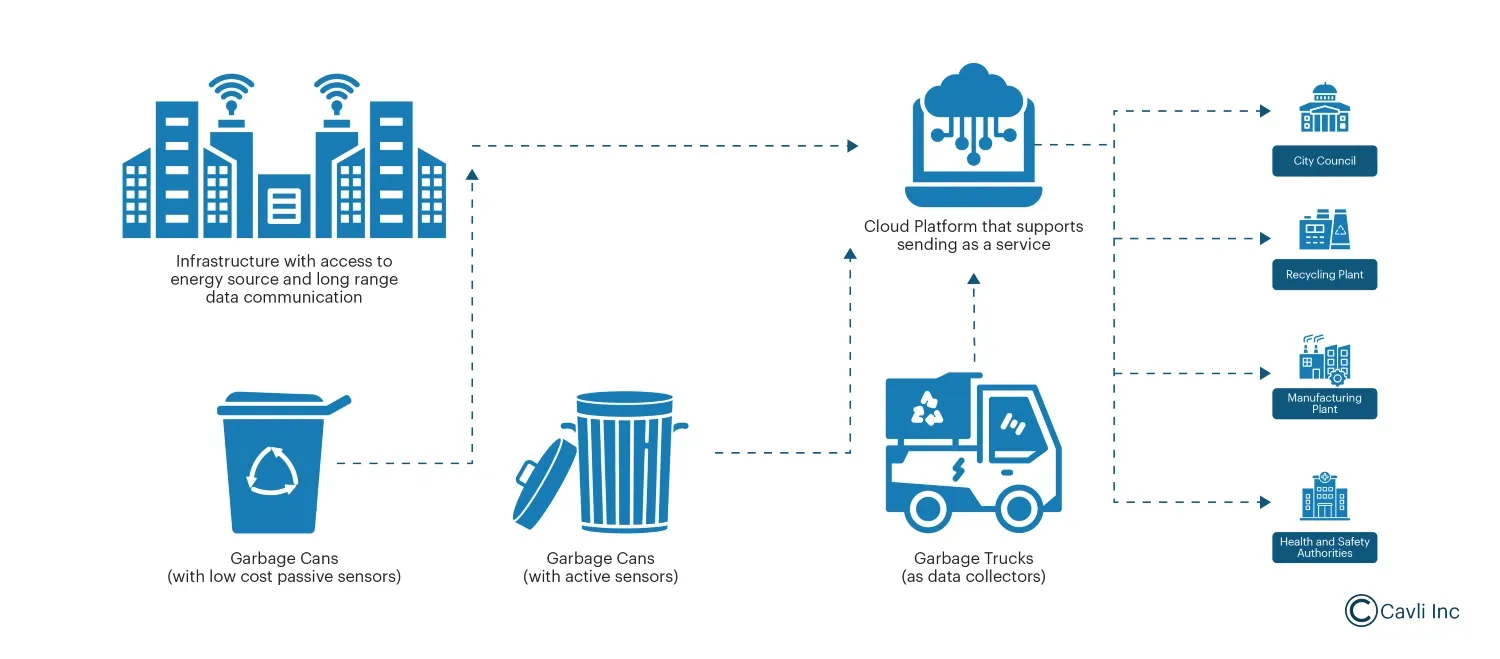
IoT-based waste management uses sensor-equipped waste bins and optimized collection routes to improve efficiency. This smart waste management solution reduces operational costs and enhances recycling rates.
- Fill-level sensors in waste containers
- Dynamic route optimization for collection vehicles
- Automated sorting and recycling systems
- Real-time fleet management
Cities like Seoul have implemented IoT-based waste management systems that have reduced collection costs by 83% and increased recycling rates.
Related Cellular IoT Modules
Cavli’s Cellular IoT modules enable smart solutions for environmental monitoring, smart parking, utility metering, street lighting, and waste management, optimizing resource use and enhancing city infrastructure.
How Cellular IoT Connectivity Powers Smart Cities
Cellular IoT technology serves as the backbone of smart city communications, providing the reliable, secure connectivity needed for critical urban systems. Smart City IoT solutions play a crucial role in enabling enhanced urban living features through advanced cellular IoT modules and connectivity management platforms like Cavli Hubble.
Comprehensive Connectivity Solutions for Smart Cities
Modern smart cities require robust, flexible connectivity solutions that can adapt to a variety of use cases. Cellular IoT provides this flexibility with multiple technology options tailored for different smart city applications:
LTE-M and NB-IoT: Low-Power Connectivity
LTE-M and NB-IoT are low-power wide-area network (LPWAN) technologies, ideal for long-range, low-bandwidth applications. These technologies are especially suitable for:
- Smart utility meters
- Environmental sensors
- Asset tracking devices
- Smart parking sensors
The advantage of LTE-M and NB-IoT lies in their ability to provide deep indoor coverage while maintaining low power consumption, which enables battery-powered devices to operate for years without the need for maintenance.
5G Networks: High-Speed and Low-Latency Connectivity
5G network technology, including 5G NR and 5G RedCap, is designed for bandwidth-intensive and latency-sensitive applications. With the power of 5G, smart cities can support:
- Real-time video surveillance
- Connected vehicle systems
- Emergency response coordination
- Public safety networks
Device Management and Security in Smart Cities
Effective device management is critical to ensuring the security and reliability of IoT devices in smart cities. Cellular IoT platforms offer robust tools for managing devices and ensuring security:
Remote Device Management for Seamless Operations
- Over-the-air firmware updates: Allows city administrators to remotely deploy firmware updates, ensuring devices are running the latest versions and reducing the need for manual interventions.
- Performance monitoring: Provides real-time insights into device performance, helping city authorities identify and address issues proactively.
- Battery life optimization: Uses power-saving algorithms and deep-sleep modes to extend battery life, which is critical in low-power IoT networks like LTE-M and NB-IoT.
- Network diagnostics: Ensures connectivity health by continuously monitoring network performance and detecting connectivity issues before they disrupt services.
Security Features for Safe and Secure IoT Networks
Modern cellular IoT solutions incorporate multiple layers of security to protect against potential threats:
- Hardware-level encryption
- Secure boot mechanisms to ensure device integrity
- Advanced authentication protocols for secure communication
- Regular security patches to address vulnerabilities and keep systems up-to-date
Key Benefits of IoT-Powered Solutions for Smart Cities
The implementation of IoT solutions in urban environments delivers tangible benefits across multiple dimensions. Let's explore how these smart systems transform city life:
Enhanced Quality of Life
Smart city technologies directly impact residents' daily experiences. Imagine starting your day with real-time updates about your optimal commute route, based on current traffic conditions and public transport status. Your smartphone app might suggest leaving 10 minutes earlier than usual due to a temporary road closure, helping you avoid delays and stress.
The same systems that make commuting easier also help create safer, more livable neighborhoods. Smart street lighting adjusts to ambient conditions and pedestrian presence, improving safety while conserving energy. Public spaces become more responsive to community needs, with automated systems managing everything from irrigation in parks to waste collection schedules.
Resource Optimization
One of the most significant advantages of smart city systems is their ability to optimize resource usage. Consider water management as an example: Smart water meters and leak detection systems can reduce water waste by up to 30% in some cities. These systems use AI-powered analytics to:
- Detect and locate leaks in real-time
- Predict maintenance needs before major issues occur
- Optimize water pressure based on actual demand
- Monitor water quality continuously
This level of resource management extends to energy usage as well. Smart grids enable cities to:
- Balance power distribution more effectively
- Integrate renewable energy sources seamlessly
- Respond to peak demand periods automatically
- Reduce overall energy consumption
Economic Benefits
The economic impact of smart city initiatives extends far beyond direct cost savings. These technologies create new business opportunities while improving the efficiency of existing operations. For example, smart city data platforms have given rise to innovative startups that develop applications for everything from parking optimization to local service delivery.
Cities implementing comprehensive IoT solutions typically see returns on investment through multiple channels. A smart lighting system, for instance, might reduce energy costs by 50-70% through LED technology and adaptive controls. However, the same infrastructure can also generate revenue by serving as a platform for:
- Digital advertising displays
- Public WiFi services
- Environmental monitoring stations
- Emergency alert systems
Perhaps most importantly, smart city infrastructure attracts businesses and talent. Companies increasingly consider digital infrastructure when choosing locations for offices or operations centers, making smart city capabilities a crucial factor in economic development.
Resource Efficiency and Cost Savings
Smart cities harness IoT data to optimize resource consumption. For instance, smart grids dynamically adjust energy distribution based on demand, reducing wastage and costs. Similarly, smart water management systems identify leaks in real-time, saving water and money.
Enhanced Public Safety and Security
IoT-based surveillance systems, equipped with smart cameras and sensors, enable real-time monitoring and predictive policing. AI integration can help analyze patterns in criminal activity, preventing incidents before they escalate, enhancing the IoT smart city security.
Traffic Optimization
IoT-enabled traffic management systems collect real-time data from vehicles and road sensors. This helps adjust traffic lights dynamically, reducing congestion and emissions. Imagine smart cities where emergency vehicles can navigate through heavy traffic with intelligent, responsive traffic signals.
Sustainability and Environmental Monitoring
Smart city solutions utilize IoT sensors to monitor air and water quality, providing actionable insights for environmental policy decisions. By identifying pollution sources in real-time, cities can proactively address environmental challenges.
Challenges in Implementing IoT Solutions for Smart Cities
While the benefits of smart cities are compelling, implementing these solutions comes with significant challenges that cities must carefully navigate.
Technical Integration Challenges
One of the most complex aspects of smart city implementation is integrating new technologies with existing infrastructure. Many cities face the challenge of working with legacy systems that weren't designed for digital connectivity. For instance, upgrading a traditional power grid to a smart grid requires careful planning to ensure uninterrupted service while new systems are implemented.
Integration challenges typically involve:
- Hardware Compatibility: Ensuring new IoT devices can work with existing infrastructure
- Data Standardization: Creating unified data formats across different systems
- Network Coverage: Providing reliable connectivity across diverse urban environments
The solution often lies in adopting open standards and implementing middleware platforms that can bridge the gap between old and new systems. Cities like Barcelona have successfully tackled this challenge by developing a standardized IoT platform that acts as a universal translator between different urban systems.
Security and Privacy Considerations
As cities become more connected, they also become more vulnerable to cyber threats. Security in smart cities must be approached holistically, considering both digital and physical aspects of infrastructure protection.
Consider a smart traffic management system. It must protect against:
Traditional Cybersecurity Threats:
- Network intrusions
- Data theft
- Signal manipulation
Physical Security Risks:
- Sensor tampering
- Infrastructure damage
- Device theft
To address these challenges, successful smart city implementations typically employ a multi-layered security approach that includes:
- End-to-End Encryption: Protecting data from the sensor level through transmission and storage
- Authentication Protocols: Ensuring only authorized devices and users can access the system
- Regular Security Audits: Identifying and addressing vulnerabilities proactively
- Physical Security Measures: Protecting hardware components from tampering or damage
Scalability Issues
As IoT networks grow, managing and maintaining these devices becomes increasingly complex. Scaling up a city-wide IoT network requires substantial investment and infrastructure planning, especially for seamless connectivity and data management.
Interoperability Concerns
With so many IoT devices and solutions from different vendors, ensuring that all components work harmoniously is a significant challenge. Developing standardized protocols and APIs for IoT devices can help alleviate this issue.
Emerging Trends in IoT Technology for Smart Cities
The landscape of smart city technology is constantly evolving, with new innovations emerging regularly. As urbanization grows, cities are looking to IoT solutions and advanced connectivity technologies to improve the quality of urban life. Let’s explore the most significant trends shaping the future of urban development.
5G Connectivity: Enabling IoT in Smart Cities"
5G technology is transforming the way smart cities operate by providing high-speed, low-latency communication essential for various urban applications. With 5G, smart city devices are more connected than ever, enabling everything from real-time traffic management to autonomous vehicle coordination. The two main 5G frequency bands—sub-6GHz and mmWave—each offer unique benefits to smart city ecosystems:
Sub-6GHz Bands (Below 6 GHz)
- Greater coverage and penetration through buildings and urban structures.
- Ideal for widespread applications like smart metering, environmental sensors, and traffic management systems.
- Reliable for connecting numerous IoT devices across large areas, making them key for city-wide infrastructure.
mmWave Bands (Above 24 GHz)
- Provides ultra-high speeds and low latency, but with shorter range.
- Suitable for high-density areas like city centers where demand for fast data transfer is high.
- Supports real-time applications such as augmented reality, high-definition security, and vehicle-to-everything (V2X) networks.
Together, sub-6GHz and mmWave bands enable interconnected urban systems that enhance efficiency, safety, and quality of life for city residents.
5G Integration and Advanced Connectivity
The rollout of 5G networks is significantly enhancing smart city capabilities. Unlike earlier wireless technologies, 5G IoT solutions support high bandwidth, low latency, and enhanced device density, enabling a wide array of smart city applications. Additionally, 5G networks support network slicing, which ensures that different services within the smart city IoT ecosystem receive the required resources for optimal performance.
Examples of 5G-Enabled Applications in Smart Cities:
Real-time Video Analytics: Smart cities can implement advanced video monitoring to:
- Detect incidents instantly using AI-powered video analysis.
- Track traffic patterns in real-time to enhance traffic flow.
- Monitor public spaces for safety and immediate emergency response coordination.
Connected Vehicle Networks: With advanced vehicle-to-everything (V2X) communication systems, cities can:
- Prevent accidents by coordinating real-time vehicle movements.
- Optimize traffic flow automatically with connected vehicles.
- Support autonomous vehicle operation and emergency vehicle prioritization in real-time.
AI and Machine Learning Integration in Smart Cities
Artificial Intelligence (AI) and Machine Learning (ML) are revolutionizing the way smart city technologies process and utilize vast amounts of data from IoT sensors. These technologies enable cities to move from reactive to predictive operations, driving more efficient urban management and decision-making.
Practical Applications of AI and ML in Smart Cities:
Predictive Maintenance:
AI algorithms analyze data from infrastructure components to:
- Predict equipment failures before they occur.
- Schedule maintenance at optimal times, reducing downtime.
- Minimize repair costs and extend the lifespan of infrastructure.
Urban Planning Optimization:
Machine learning models help smart city networks:
- Identify patterns in population movement and foot traffic.
- Predict future development needs, from residential to commercial areas.
- Optimize public transportation routes based on demand.
- Support sustainable urban growth through predictive insights.
Edge Computing for Faster Decision-Making in Smart Cities
Edge computing is becoming an essential part of smart city infrastructure. It allows data processing closer to the source of collection, reducing latency and bandwidth usage. This is crucial for applications that require real-time data processing, such as traffic management systems and real-time surveillance. By processing data locally, edge computing also helps mitigate the impact of bandwidth constraints and reduces the load on central servers.
Blockchain for Smart Cities
Blockchain technology is emerging as a critical component for securing transactions in smart cities. By providing immutable, transparent records and secure communication, blockchain enhances trust in systems like voting, public service management, and energy distribution. Smart cities can leverage blockchain for secure data sharing and peer-to-peer energy trading, empowering citizens while maintaining transparency.
Closing Notes
Smart cities represent a fundamental shift in how urban environments operate and serve their citizens. Through the integration of IoT technology, particularly cellular IoT solutions, cities can become more efficient, sustainable, and responsive to citizen needs. As we continue to face challenges like climate change, population growth, and resource constraints, smart city solutions will become increasingly crucial for creating livable, resilient urban environments.
The success of IoT in smart cities depends on choosing the right technology partners and solutions. Cellular IoT technology, like the solutions provided by Cavli Wireless, offers the reliable, secure connectivity foundation required to build truly smart cities using IoT. As we look to the future, the continued evolution of these technologies will unlock even more possibilities for urban innovation and improvement.
Go Beyond and Explore
How is IoT used in smart cities?
IoT is central to smart cities, connecting devices, sensors, and systems to collect and exchange real-time data. Applications include smart traffic management, environmental monitoring, utility management, and public safety. IoT optimizes urban services, reduces resource wastage, and enhances livability through data-driven decision-making.
What are smart city solutions?
Smart city solutions include integrated technologies like smart transportation, grids, waste management, and healthcare systems. These solutions utilize IoT, AI, and big data analytics to improve infrastructure, enhance public services, and streamline governance for sustainable urban development.
What are the key technologies used in smart cities?
Key technologies powering smart cities include IoT for connectivity, AI for predictive analytics, 5G for high-speed communication, cloud and edge computing for efficient data processing, and big data analytics for actionable insights. These technologies work together to enhance urban operations and sustainability.
What is smart city architecture in IoT?
Smart city IoT architecture is a layered framework comprising the perception layer (sensors and actuators), communication layer (5G, LTE-M), data management layer (processing and analytics), and application layer (smart grids, transportation). This structure enables seamless integration and efficient urban service delivery.
What are the advantages of smart cities?
Smart cities offer improved quality of life, optimized resource usage, economic growth, enhanced public safety, and environmental sustainability. They leverage IoT and AI technologies to create efficient, livable urban ecosystems, making daily life easier and more sustainable for residents.
What is the difference between smart city and smart home in IoT?
A smart city applies IoT on a large scale to optimize urban infrastructure and services, such as transportation and utilities, while a smart home focuses on convenience, security, and energy efficiency within a residential setting. Both enhance functionality but differ in scale and scope.


